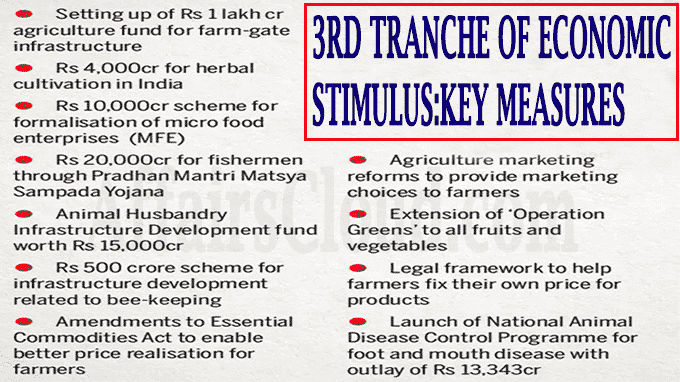 On May 15, 2020, Union Finance & Corporate Affairs Minister Smt. Nirmala Sitharaman detailed the third part of the Special economic and comprehensive package of Rs 20 lakh crores to support Indian economy in the fight against COVID-19 during her 3rd press conference in New Delhi. Its first part was presented on May 13, 2020 Click Here to Read while its Part 2 was presented on May 14.Click Here to Read.
On May 15, 2020, Union Finance & Corporate Affairs Minister Smt. Nirmala Sitharaman detailed the third part of the Special economic and comprehensive package of Rs 20 lakh crores to support Indian economy in the fight against COVID-19 during her 3rd press conference in New Delhi. Its first part was presented on May 13, 2020 Click Here to Read while its Part 2 was presented on May 14.Click Here to Read.
- The Part 3 of “Atmanirbhar Bharat Abhiyaan” (self-reliant India Movement) is consisted of 11 measures. 8 measures are for improving agricultural infrastructure and 3 measures are for administrative and governance reforms, including removing restrictions on sale and stock limits of farm produce.
Following are the details of the third tranche of package starting with 8 measures to strengthen Infrastructure Logistics and Capacity Building for Agriculture, Fisheries and Food Processing Sectors
–NABARD anchored Rs 1 lakh crore Agri Infrastructure Fund for farm-gate infrastructure for farmers
The Central government has allocated Rs 1 lakh crore to fund Agriculture Infrastructure Projects at farm-gate & aggregation points (Primary Agricultural Cooperative Societies, Farmers Producer Organizations, Agriculture entrepreneurs, Start-ups, etc.). This fund will be financed and managed by National Bank for Agriculture & Rural Development (NABARD). This fund will be used for setting up cold chains and post-harvest management infrastructure.
About NABARD:
Headquarter– Mumbai, Maharashtra
Chairman– Harsh Kumar Bhanwala
–Rs 10,000 crore scheme for Formalisation of Micro Food Enterprises (MFE)
With an objective to promote “Vocal for Local with Global outreach”, Rs 10,000 crore schemes have been launched by the government to help 2 lakh MFEs with technical upgradation to attain FSSAI food standards, build brands and marketing.
- This scheme will support existing MFEs, Farmer Producer Organisations (FPOs), Self Help Groups (SHGs), and Cooperatives.
- It will follow a cluster-based approach i.e. government would focus on the particular produce of a region to boost its production, marketing and health and safety standards. For eg: mango in Uttar Pradesh (UP), kesar in Jammu & Kashmir (J&K), bamboo shoots in North-East, chilli in Andhra Pradesh, tapioca in Tamil Nadu.
- These measures would also help in the export of these products in untapped markets.
What is Vocal for Local?
It is an initiative started by Prime Minister Narendra Modi by urging people to use local products and also advertise them to make them global.Buying Indian products will give the required boost to Indian economy, which is facing a downward trend amid lockdown to contain COVID-19 spread.
–20,000 crore allocated for fisherman through Pradhan Mantri MatsyaSampada Yojana (PMMSY)
The government has allocated Rs 20,000 crore for fishermen through the PMMSY for development of marine and inland fisheries. Of this, Rs 11,000 crore will be allocated for activities in marine, inland fisheries and aquaculture while Rs 9,000 crore for developing infrastructure of fishing harbors, cold chains, markets, etc.
- The development will lead to additional Fish Production of 70 lakh tones over 5 years, and double the exports to Rs 1,00,000 crore. It also generates employment to over 55 lakh persons and doubles the exports to Rs 1,00,000 crore.
- The focus will be on Islands, Himalayan States, North-east and Aspirational Districts with a provision of Ban Period Support to fishermen (during the period fishing is not permitted), Personal & Boat Insurance.
What is PMMSY?
Initiated in 2019, it aims to promote Blue Revolution (NeeliKranti) i.e. development of fish and aqautic products, to address infrastructure gaps in the fisheries sector. It was established under the Department of Fisheries.
–Rs. 13,343 crNational Animal Disease Control Programme launched
Centre has launched National Animal Disease Control Programme for Foot and Mouth Disease (FMD) and Brucellosis with total outlay of Rs. 13,343 crore to ensure 100% vaccination of cattle, buffalo, sheep, goat and pig population (total 53 crore animals) for Foot and Mouth Disease (FMD) and for brucellosis.
- Till date, 1.5 crore cows & buffaloes tagged and vaccinated.
–Rs. 15,000 crAnimal Husbandry Infrastructure Development Fundto be formulated
An Animal Husbandry Infrastructure Development Fund (AHIDF)worth Rs 15,000 crorewill be set upby the Centre to support private investment in dairy processing, value addition and cattle feed infrastructure.The incentives will be given for establishing plants for exports of niche products
–Rs. 4,000 cr allocated to promote Herbal Cultivation
Centre will provide Rs. 4,000 crore to cover 10,00,000 hectareunder Herbal cultivation in next two years.This will lead to Rs. 5,000 crore income generation for farmers and will also develop a network of regional Mandis for medicinal plants.
- Already, the National Medicinal Plants Board (NMPB) has supported 2.25 lakh hectare area under cultivation of medicinal plants.
- A corridor of medicinal plants would also be created on the banks of the River Ganga, to be identified by NMPB.
–Rs 500 cr allocated towards Beekeeping initiatives
The government has earmarked Rs 500 crore for beekeeping initiativesunder which infrastructure development related to integrated beekeeping development centres, collection marketing and storage centres, post-harvest and value addition facilities will be providedamong other things.
- This will increase the income of 2 lakh bee-keepers.
–From ‘TOP’ to TOTAL: “Operation Greens” extended with Rs 500 cr
“Operation Greens” run by Ministry of Food Processing Industries (MOFPI) will be extended from tomatoes, onion and potatoes to ALL fruit and vegetables with an allocation of Rs 500 crore.
- The Scheme would provide 50% subsidy on transportation from surplus to deficit markets, 50% subsidy on storage, including cold storages and will be launched as pilot for the next 6 months.
- This will lead to better price realisation to farmers, reduced wastages, affordability of products for consumers.
Following are the 3 measures for administrative and governance reforms, including removing restrictions on sale and stock limits of farm produce
–Amendments to Essential Commodities Act, 1955 to enable better price realisation for farmers
The government will amend the 65 years old Essential Commodities Act (ECA), 1955to enable better price realization for farmers
- Agriculture food stuffs including cereals, edible oils, oilseeds, pulses, onions and potato will be deregulated
- The amendment will provide adequate choices to farmer to sell produce at attractive price,
- No stock limit will apply to processors or value chain participants following amendment and stock limits will be imposed only under very exceptional circumstances like national calamities, famine after amendment of ECA
What is ECA?
ECA was enacted in 1955 by Parliament to ensure that the delivery of certain commodities don’t get blocked by hoarding or blackmarketing. The government used this act to regulate the production, supply and the distribution of certain products to make them available to consumers at a fair price.
–Agriculture Marketing Reforms to provide marketing choices to farmers
A Central law will be formulated to provide
- Adequate choices to the farmer to sell their produce at remunerative price;
- Barrier free Inter-State Trade;
- A framework for e-trading of agriculture produce.
–Agriculture Produce Pricing and Quality Assurance:
The Government will finalise a facilitative legal framework to enable farmers to engage with processors, aggregators, large retailers, exporters etc. in a fair and transparent manner. framework.




